Products
In the Product dashboard, click "create product" to create a product.
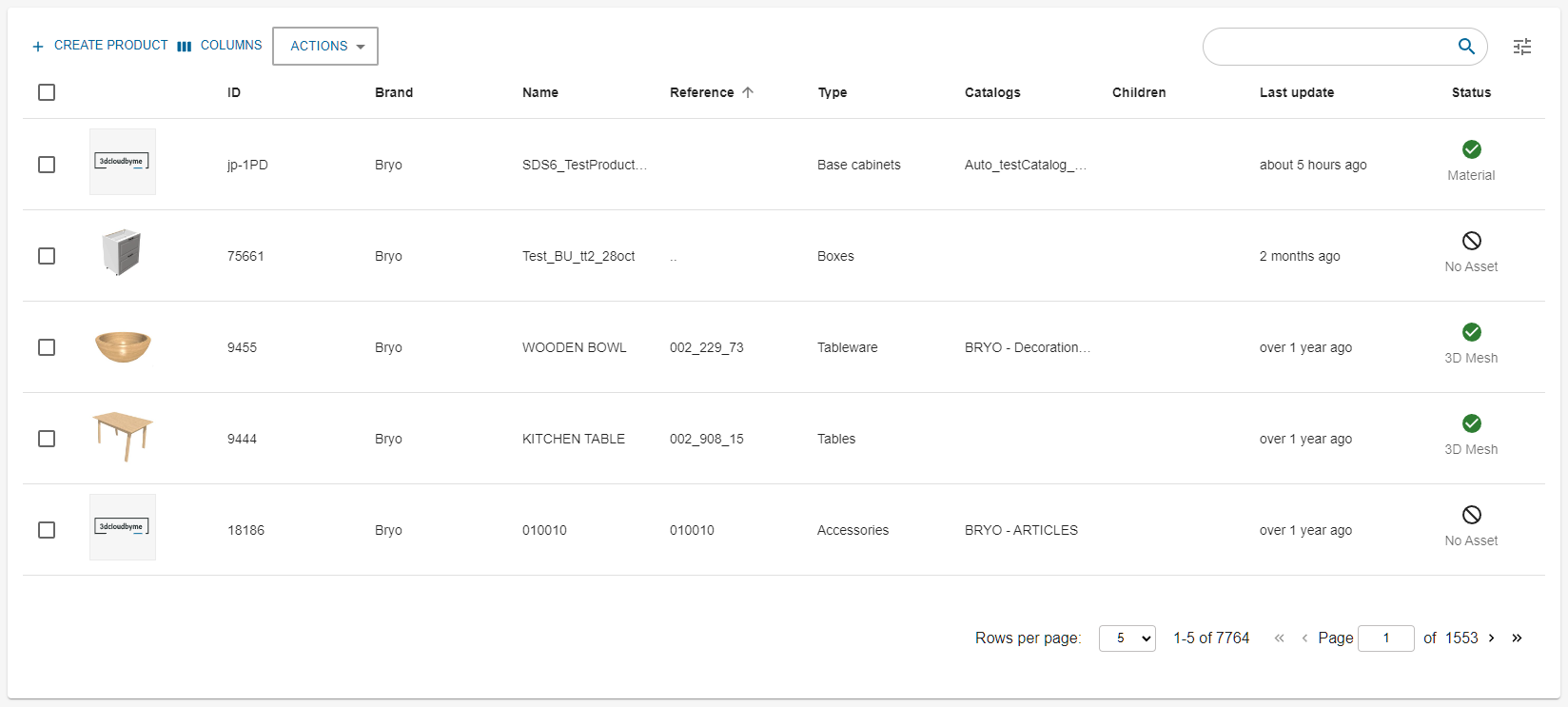
If you want to see an enlarged thumbnail, just hover the mouse over it and it will be enlarged.
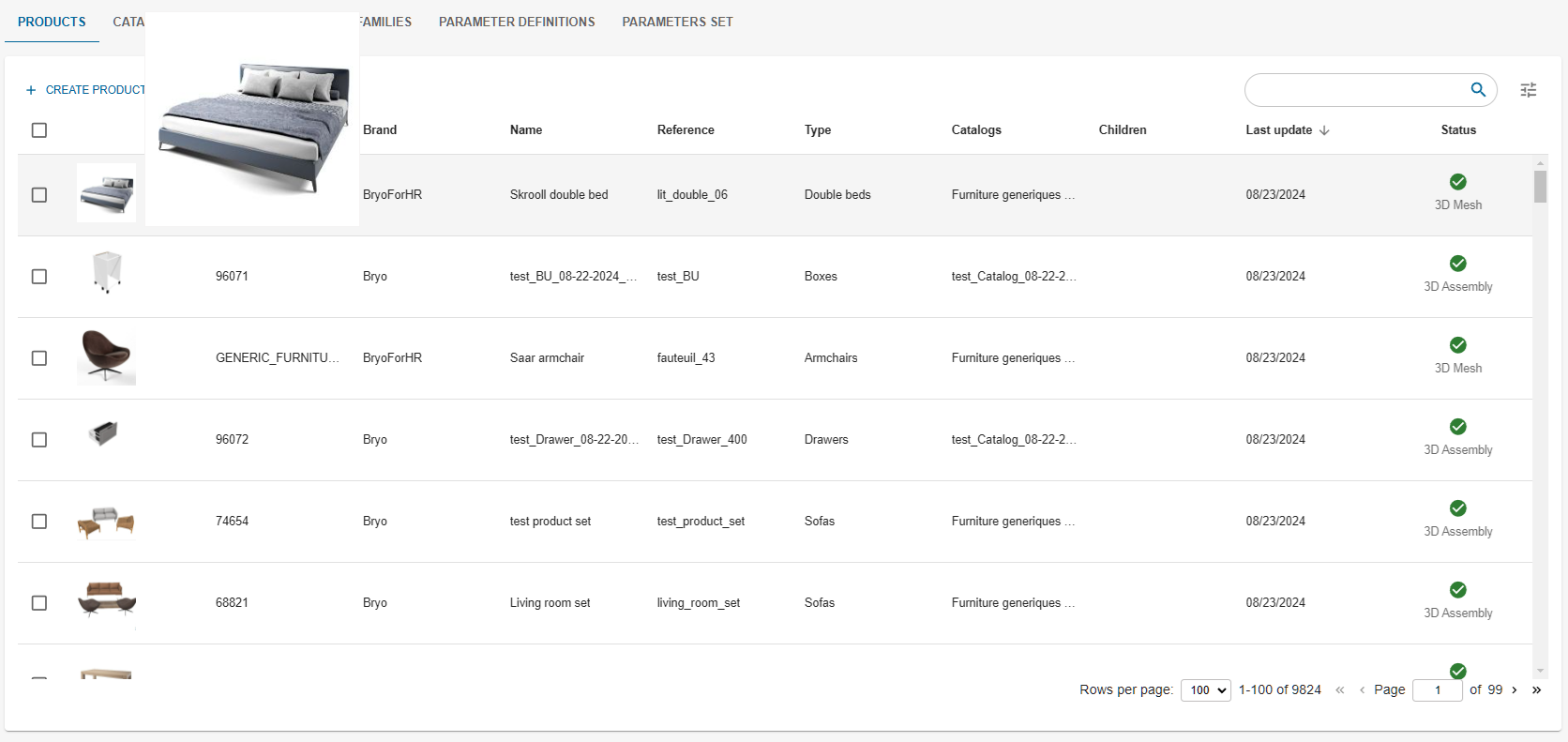
Search
The search allows you to search products based on mainly all text fields from a product. Once a search is started, a facet panel appears to the left.
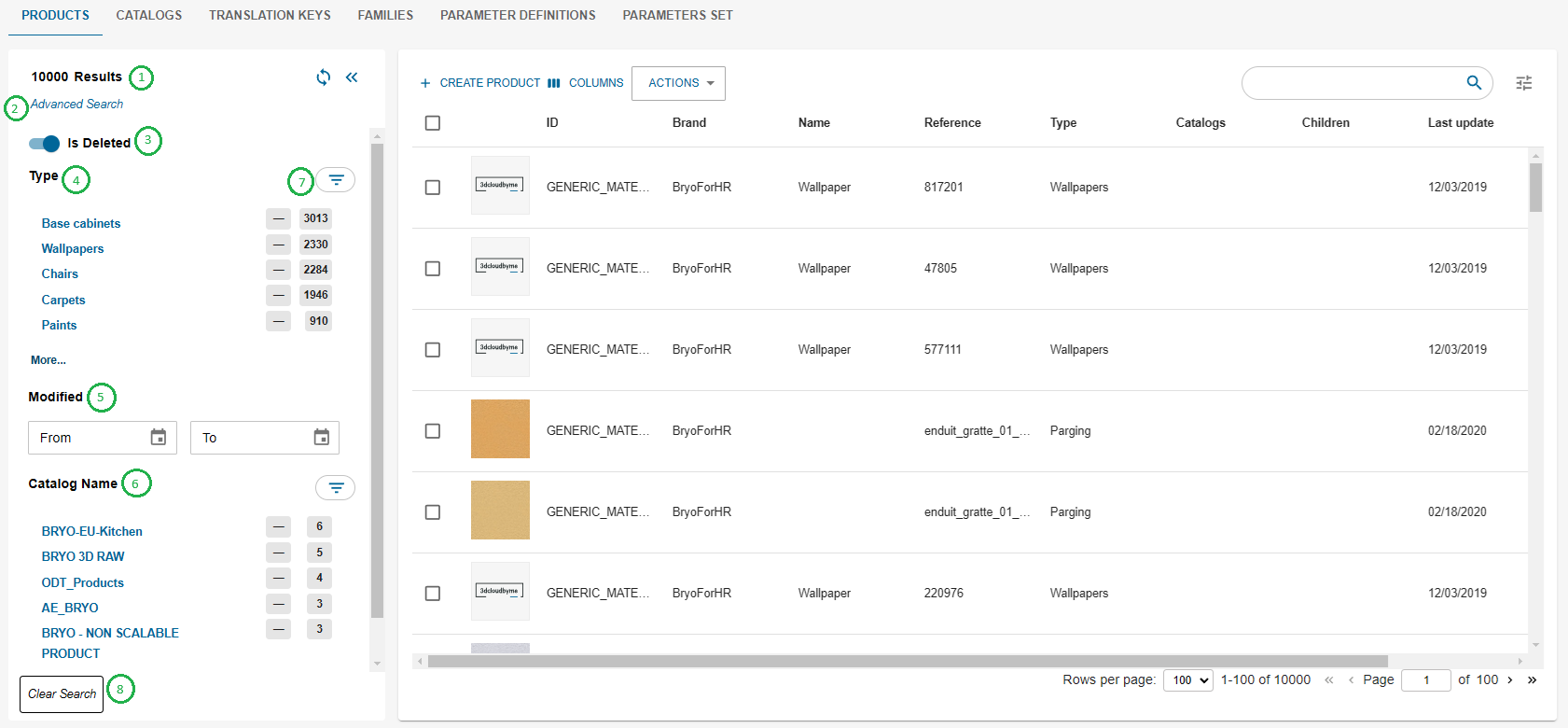
Search filter panel controls
- Results: The label shows total number of results for the basic and advanced search query
- Advanced search: Allows you to specify the search in order to reduce the amount of products in the result
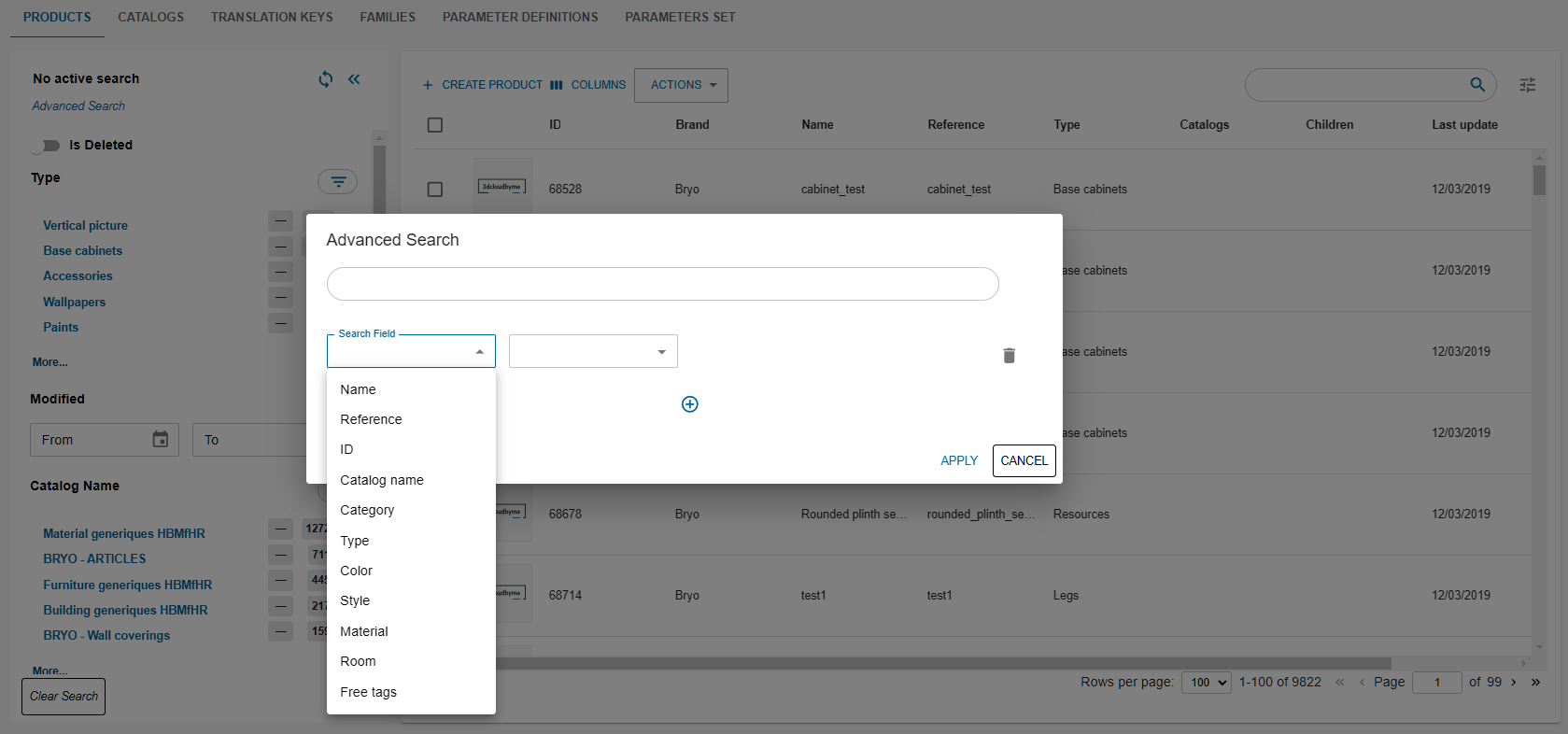 The current advance search fields are : Name, Reference, ID, Catalog name,Category, Type, *
Color*, Style, Material, Room, Free Tags, Parameters
The current advance search fields are : Name, Reference, ID, Catalog name,Category, Type, *
Color*, Style, Material, Room, Free Tags, Parameters - Is Deleted: When switch is ON, it allows you to search deleted products and if off, it shows non-deleted products.
- Type aggregations: This section allows you to search products for selected type or exclude a type from the search results.
- Modified: If a range is put here, the search will display the result matching this range for the modification date.
- Catalog aggregations: This section allows you to search products linked to selected catalog or exclude a catalog from the search results.
- Aggregation filter: Filter through aggregations (more details below)
- Clear Search: Cancel the search and return to product list without search.
Aggregation filter
Now, you can filter through the aggregations such as Product type and catalogs. For that, a filter box is provided as
shown below:
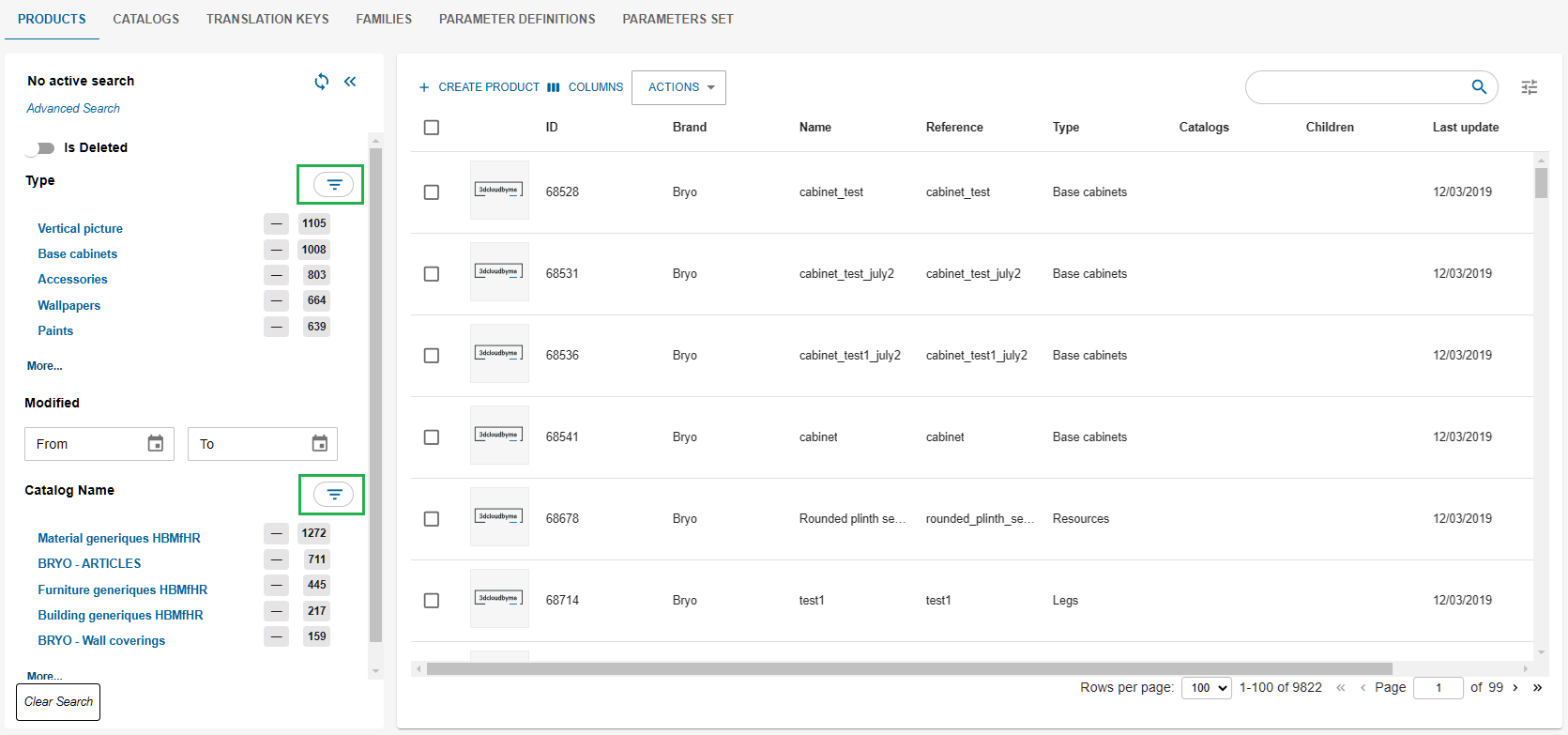
To open the filter box, just hover the mouse over it and type the text and press Enter.
For example, all kinds of cabinets aggregations can be filtered as below:
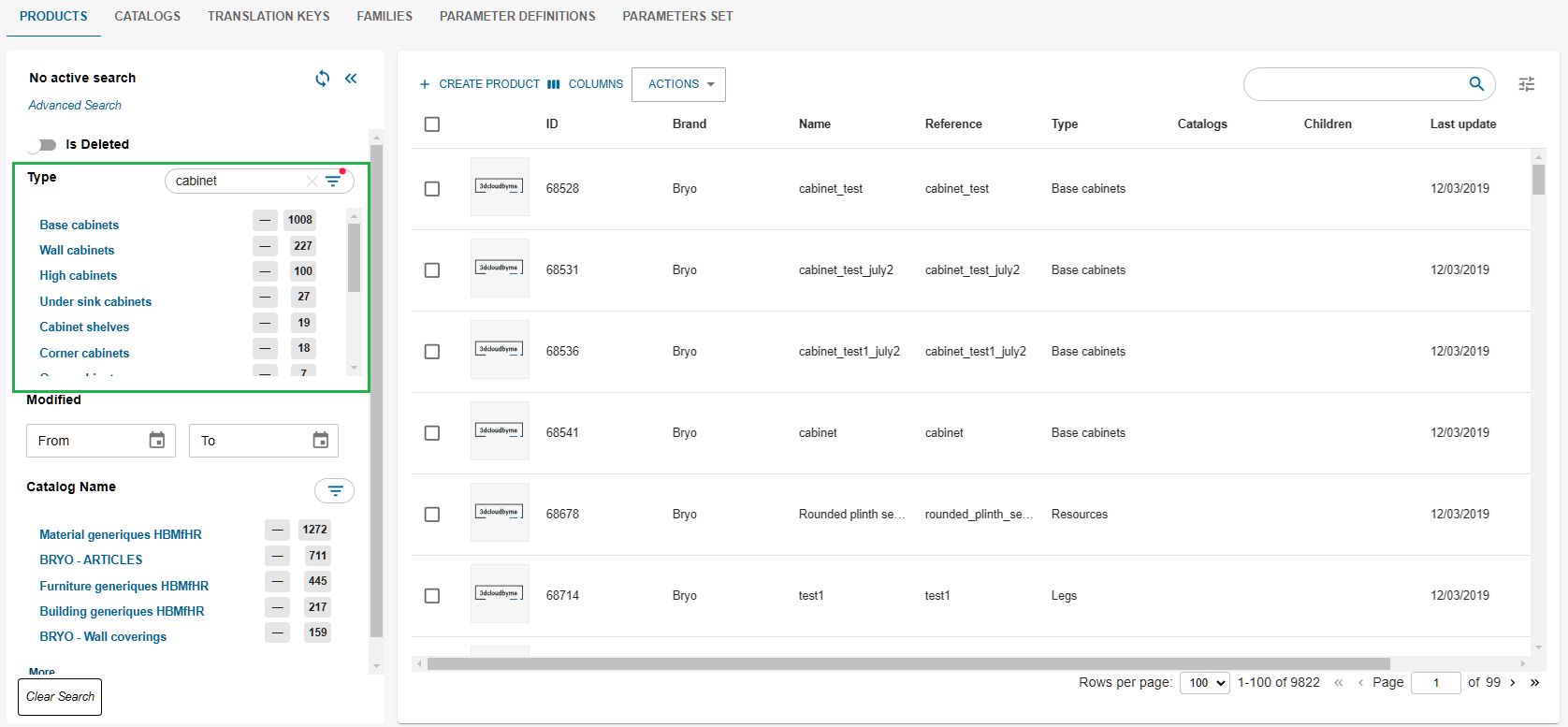
Note - Please note that, by merely filtering the aggregations (types and catalogs) does not refresh the search result. For that, you must have to click the specific aggregation.
Product Identity
Product identity is located on the top of the product page. It is where the user can fill key information:

- ID*
- Parent ID
- Reference
- Brand*
- Category*
- Type*
- Manufacturer
- Search Score
- Product Date
The id of a product is its strongest identity. A product ID is unique across all legals. Once a product is created with an id, we cannot change its id. An Id is a text that can be used inside url, so it can only contains one of these characters:
ABCDEFGHIJKLMNOPQRSTUVWXYZabcdefghijklmnopqrstuvwxyz0123456789-._~:/?#[]@!$&'()*+,;=
Product representation
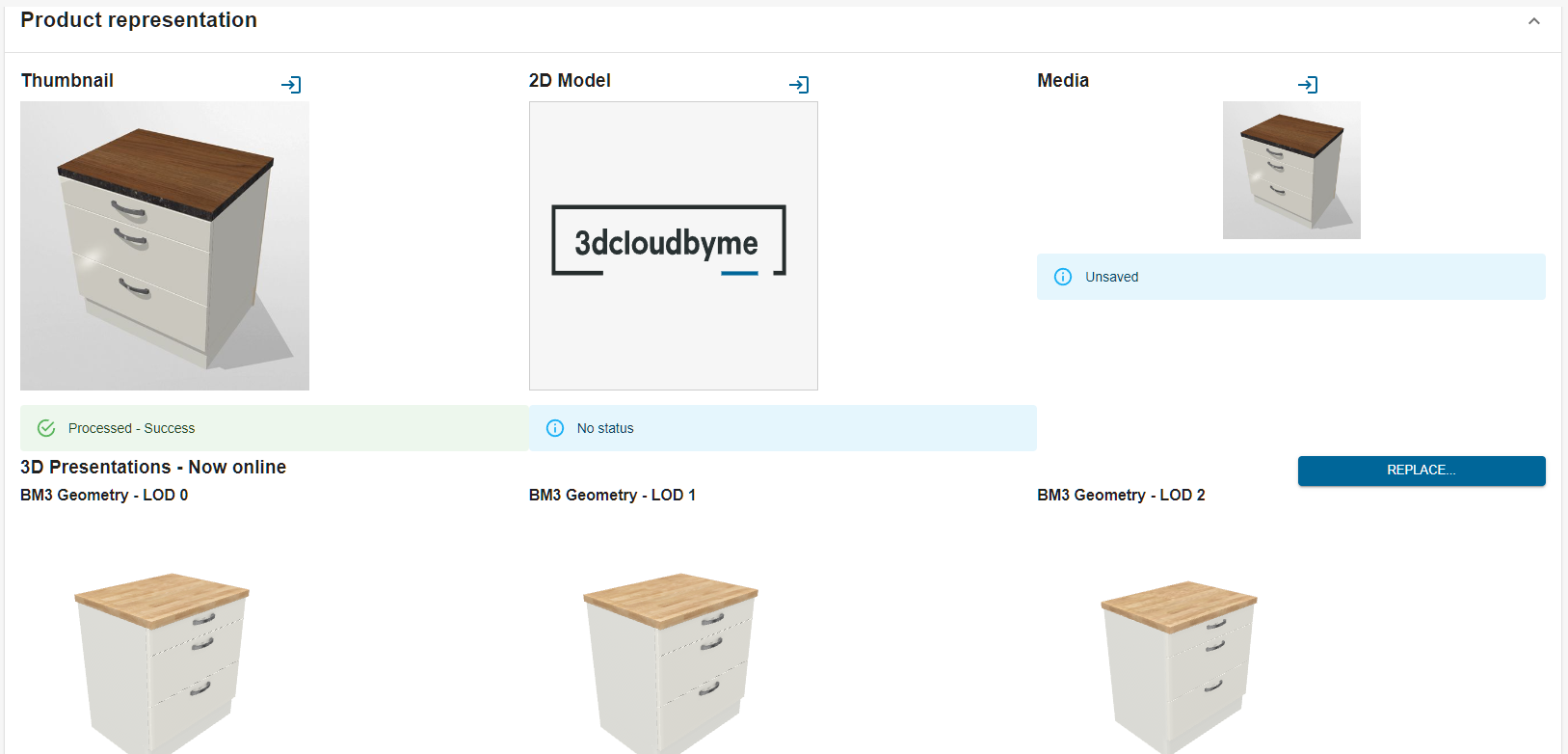
- Thumbnail
- 2d Model
- Media
- 3D Representation
The image representing the product. It is a jpg sized 512x512. If you provide an image with different specification it will be converted.
Replacing 3D Presentations
When you click on "Replace" button in Presentation section, it will open a dialog which will allow you to replace 3D
Presentations.

Small icon will take you to the LOD documentation in new tab.
Replace 3D dialog contains 3 tabs:
- 3D Geometry - Autoscale
- 3D Geometry - Manual
- Assembly
You can upload a LOD0 BM3 and LOD1, LOD2 will be computed automatically.

Once you upload BM3, some details are shown in blue at the top. Each number has a special meaning and sometimes with abbreviations, if required (For example multiples of 1000 is shows as letter "K")
- Represents number of triangles in current 3D model
- Represents texture size in current 3D model
- Represents texture weight in current 3D model
If you want to see the exact number without suffix, hover the mouse over the number and a tooltip will be appeared to show the exact number.

If you want to see the maximum allowed threshold value, hover the mouse over icon and a tooltip will be appeared to show the max threshold value.
 Note - For LOD0, there is no such limit for max value. It is infinite for LOD0.
Note - For LOD0, there is no such limit for max value. It is infinite for LOD0.
Commercial description

- Product name
- Commercial description
- Short description
- Product page link
Name of the product
The product information is localized. You can contribute them to any of the languages HBM recognize. to add a new language contribution, click on "edit contribution languages"
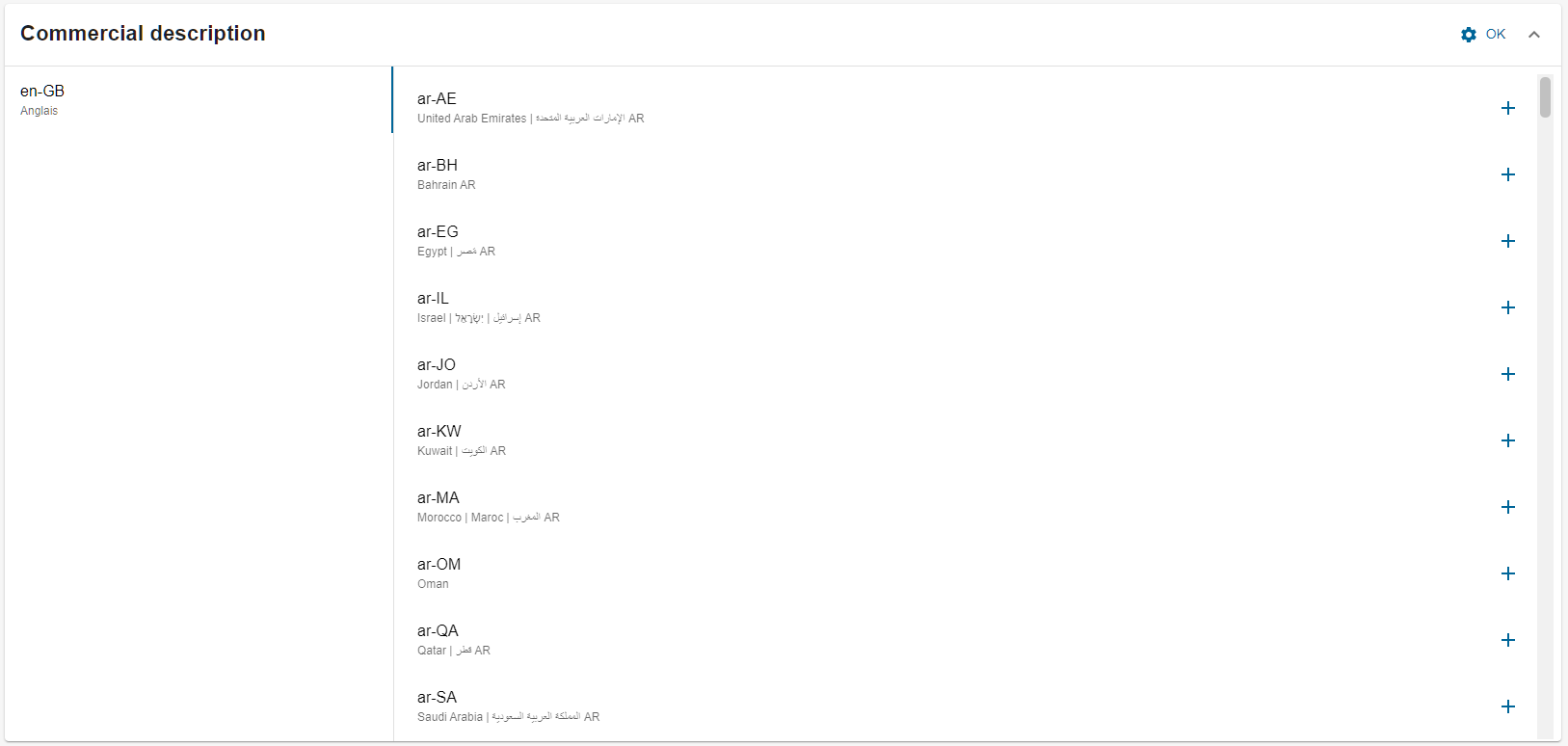
Then select the language you want to add by clicking on the + and valid the selection with the ok button at top right.
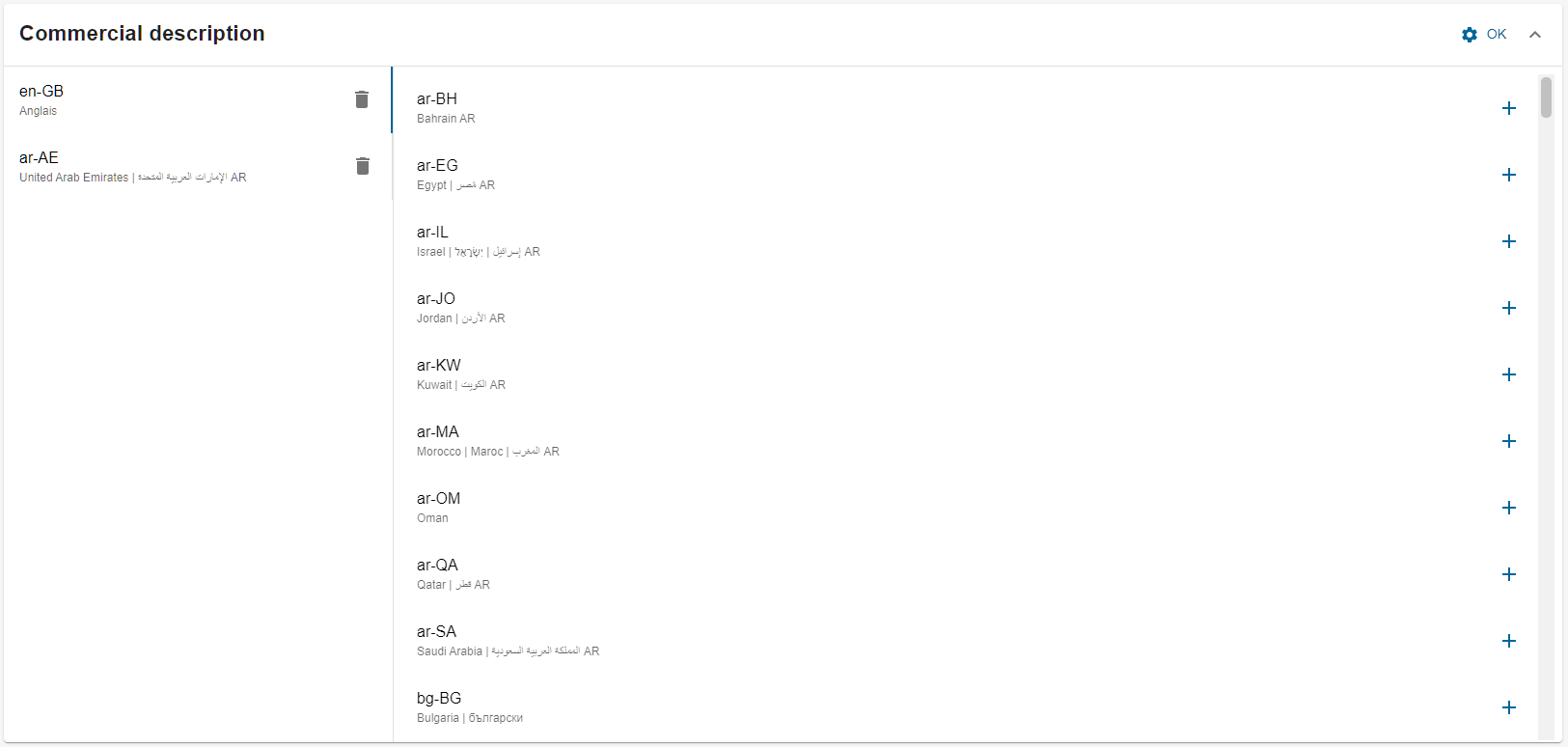
Example of the product information in Kitchen Planner:
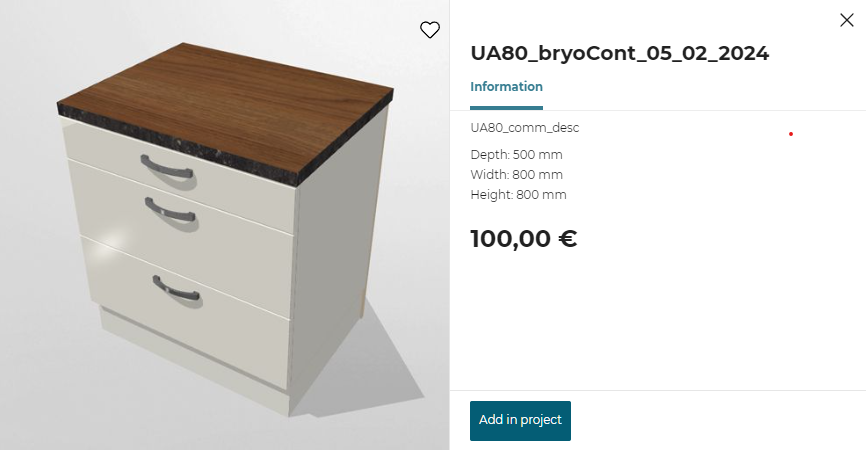
Catalogs
Here it is shown in which catalog the product is in and let a user add this product to different catalogs. either by searching by catalog name:
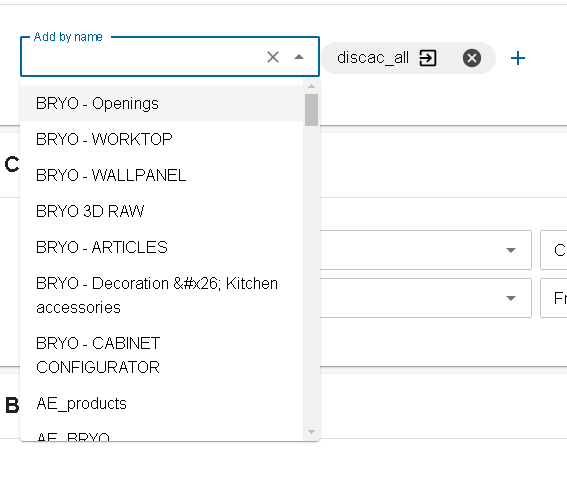
Or by clicking on the + and access the catalog dashboard and search :
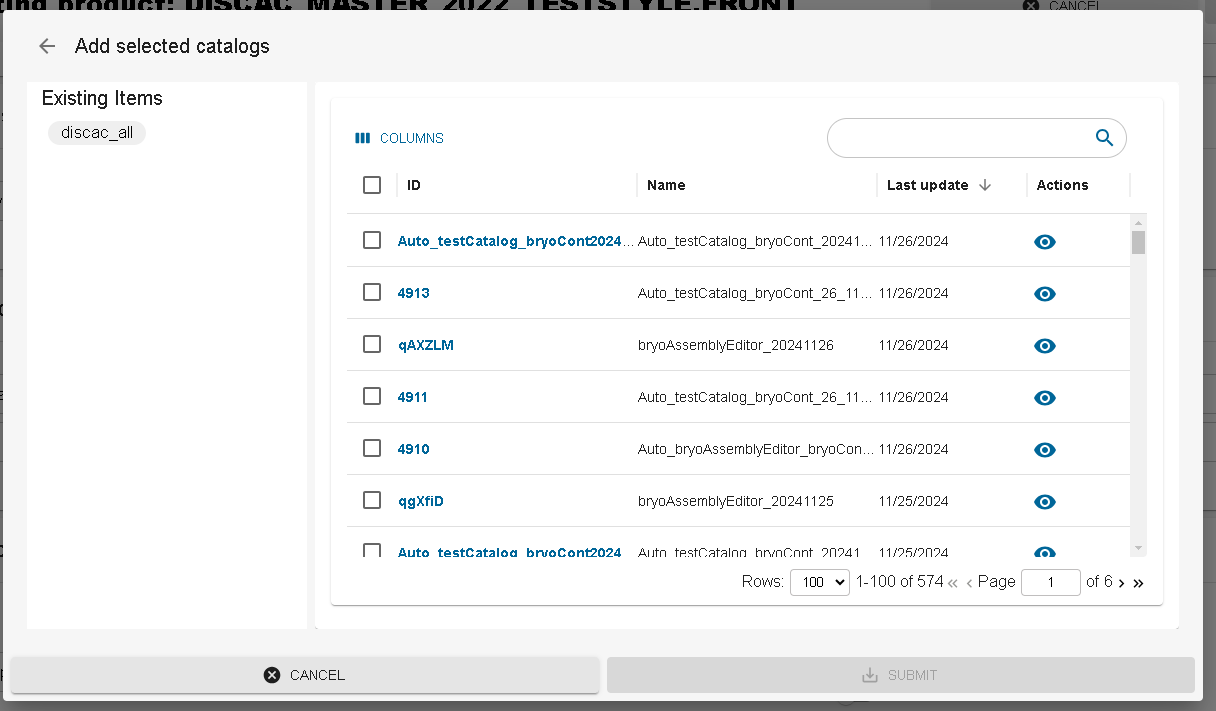
Product Classification

- Materials, Colors, Styles, Room
Material tags are used on HomeByMe.com so that the consumers can filter on a given material and find products that have the material tag (eg: Wood). Please note: this notion is independent from the Materials mentioned in the 3D section, which relate to the textures used in scene rendering.
Colors, Styles and Room work the same way. - Free tags
Free tags are used by the HomeByMe for Kitchen retailer application to select which products are part of each node of the catalog tree in the planner. The catalog tree itself is part of the configuration of the Application Distribution.
Technical information

The content of this section depends on the type of Range Item type.
- Opening Shape
- Target position
- Height from floor
- Manipulation mode
- Ungroupable
- Allow collision
- Replaceable
- Modular
Select the shape of the opening, which is used to calculate its bounding box.
Parameters
Concept
The parameters are a powerful way to build a range with a large number of variations / combinations without creating one product / resource per variation.

Parameters are typed according its purpose :
- Real: A real number in the mathematical definition. Can be discrete or continuous when exposed to the end user.
- Integer: An Integer in the mathematical definition. (A number that cannot have a comma) Can be discrete or continuous when exposed to the end user.
- Boolean: True or False
- String: List of string values
- Color: List of string values
- Material: A selection of materials
- Product: A selection of products
Attributes common to all parameter types
- Visible: The display name and the value are shown in the application
- Editable: The value can be modified by the user- within the authorized range
- Use Translation Key: Enables translation keys (see below)
- ID: Name of the parameter. It should match any corresponding parameter ID in a relationship, such as the name of a publication in a BM3, BMA parameters, and in some cases match expected parameter IDs in the application. You can find the list of expected parameters in the corresponding application documentation.
- Display name: User-facing label of the parameter name
- Translation key: When the "Use Translation Key" option is enabled, the key should be typed here, and the translation file containing the actual labels is pushed separately through APIs.
Real and Integer specific continuous
- Define minimum value, maximum value, default value, and step.
- Minimum and maximum values are part of the authorized range (lower or equals, greater or equals)
- Values are expressed in mm (imperial is only converted at display time in the consumer application)
For Real, there is also the multi-range option. Same as continuous but it allow the user to put several range of min and max.
discrete
- List of possible values, with their display name (with translation keys), and values.
- List managed through and add / remove button
- Default value
- Values are expressed in mm (imperial is only converted at display time in the consumer application)
Magnitude Allow the planner to understand if the number represent a physic notion. if so, a unit will be put after.
Product Replacement
Makes assembly components variable. The final component used in the assembly can be set by applicative behavior, or
directly by the end user.
- Manage the list of possible values,
- List managed through add / remove
- Add: from the list of all products of the legal entity
- Select default value,
- Allow any value: all the products in the legal entity can be set on this product.
- This possibility is often used at middle product structure level; the actual list of possible products being defined only once at the top assembly level.
- Allow empty value,
- Tags: Use product types to fill product replacements.
- Freetags: Use freetags to fill product replacements.
In order to match product parameter to assembly parameter,the product parameter needs to have the same ID as the BMA parameter it maps to.
Parameters are created in 3DCloud with 4 ways:
Parameters from scratch, presets, assets and definitions
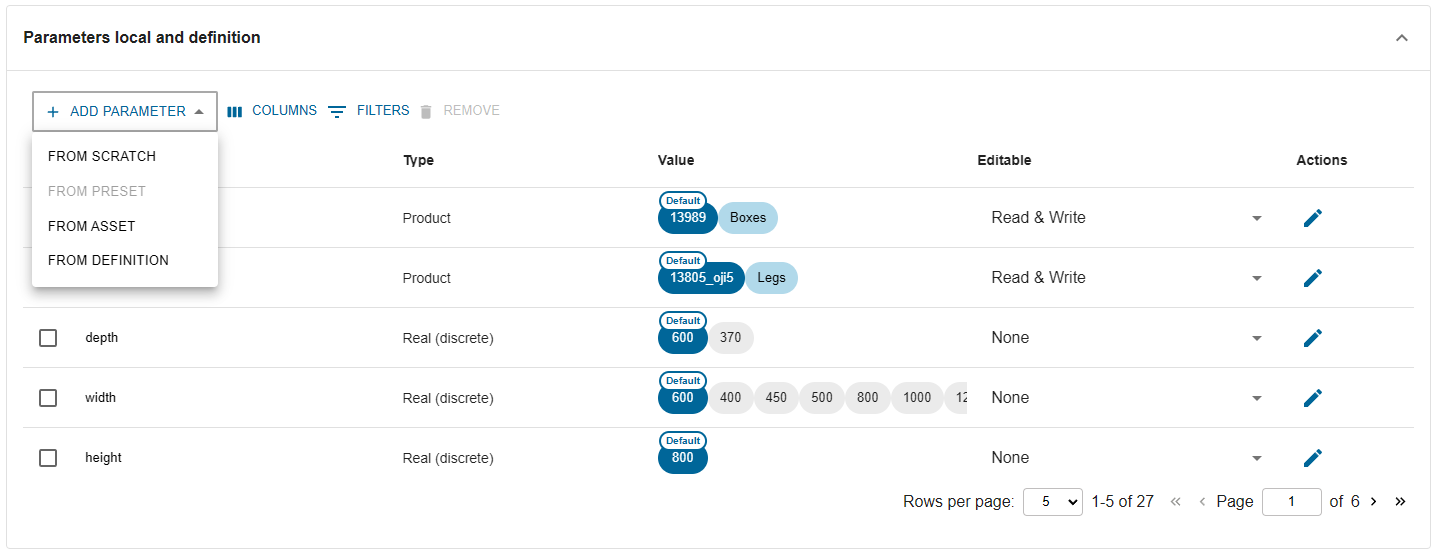
Quick creation
When creating a parameter you have the possibility to create it from scratch or with quicker preset. For now, only width, depth, height parameters are allowed to be created quickly. The product needs to be of category Furniture.
From Asset
When using an asset bm3 or BMA, we have the possibility to create the parameter with the "from asset" parameter creation.
- For BMA it will get all parameters of the BMA
- For BM3, it will get publications and smart-scales.
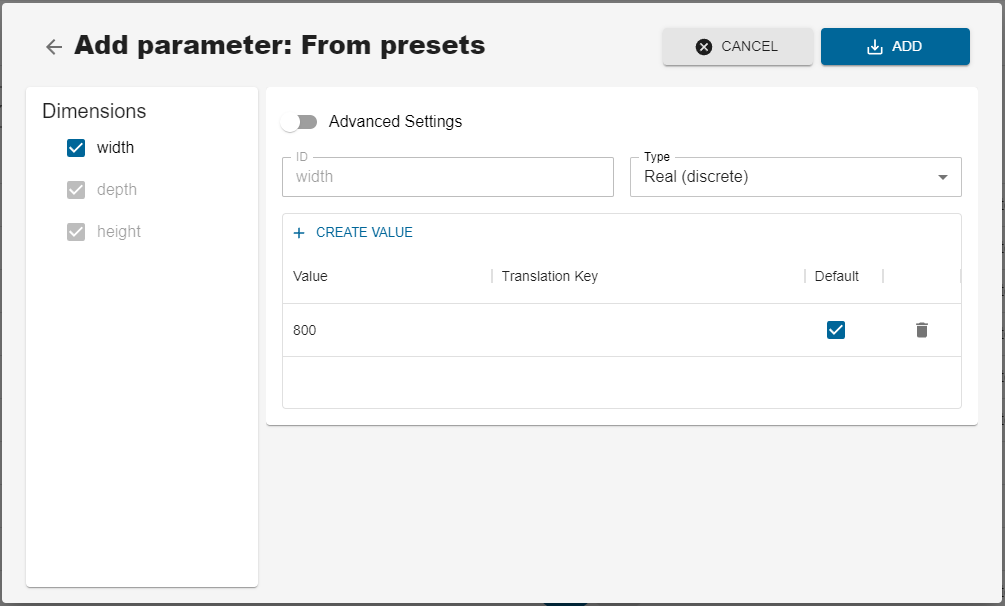
Also if a bm3 is dropped and have publication you will find the publications behind from asset publication.
From Definition
When we have product definitions already created, we have the possibility to create the parameter with "From Definition" option. Once you select this option, list of product definitions will be shown from which you can add the parameters.
Parameters from parameter sets
You can create parameters from parameter sets if the sets are already created.

When you click on "Add Parameter Set", list of parameters sets will be shown from which you can select set(s). A parameter set has zero or more parameters associated with it. You can check the parameter list of a set by clicking on " eye" icon under Actions column.
Mapping product

Mappings are used to derive product variations with different parameters, prices, references and descriptions from one
generic product.
To put this pattern in place:
- Create one product to carry the representation- a parametric BMA or BM3, making the representation scalable. It is called the Generic Product and is the one on which "Add Mapping" has to be called;
- Create several products carrying prices, description, references... of the different variations of the generic products.
- Create the mappings between the Generic Product and the N products with the two steps of the following procedure.
The product resulting from a mapping will be used only in the Bill of Material
In order to create a mapping, click on "Add mapping":

-
Choose the product reference that will be the result of your mapping. You can choose any product within your legal entity.
-
click on add a condition
-
Select the parameter that will be tested
-
Choose your comparative operator when several are available
-
Then select the value the parameter should be tested with.

You can add several condition that should be all satisfied to lead to the product reference.
It can happen that several lines of mapping are satisfied. In this case, the priority will be used to know which mapping result is to consider before another.
If you add a mapping to a product, it will become a generic product. There is no coming back! Also, if a mapping is declared on a product, the price section will be ignored.
Prices
More information for prices can be found here
Click "Add price" to add a price to the product.
- Type
You can select it from the available price types: regular, membership, reduced, ecoFee. If the price type that you want to set is not present in the list, you can define your own by just typing it inside
the textbox.
If the price type that you want to set is not present in the list, you can define your own by just typing it inside
the textbox. - value
The price of the product. - Currency
Select the currency for the price. - Market zone It is a free text. Enter the market zone you need.
- Dates
It is mandatory to define a start date and an end date for each price. The date intervals of the different prices should not overlap. The application displays the price which is active at the current date, if any. Give a start date and end date for this price. The price appears in the consumer application within this period. - Parameters
JSON that allows the contributor to customize some specific criteria. Check pricing parameters for more details.
Configuration Set
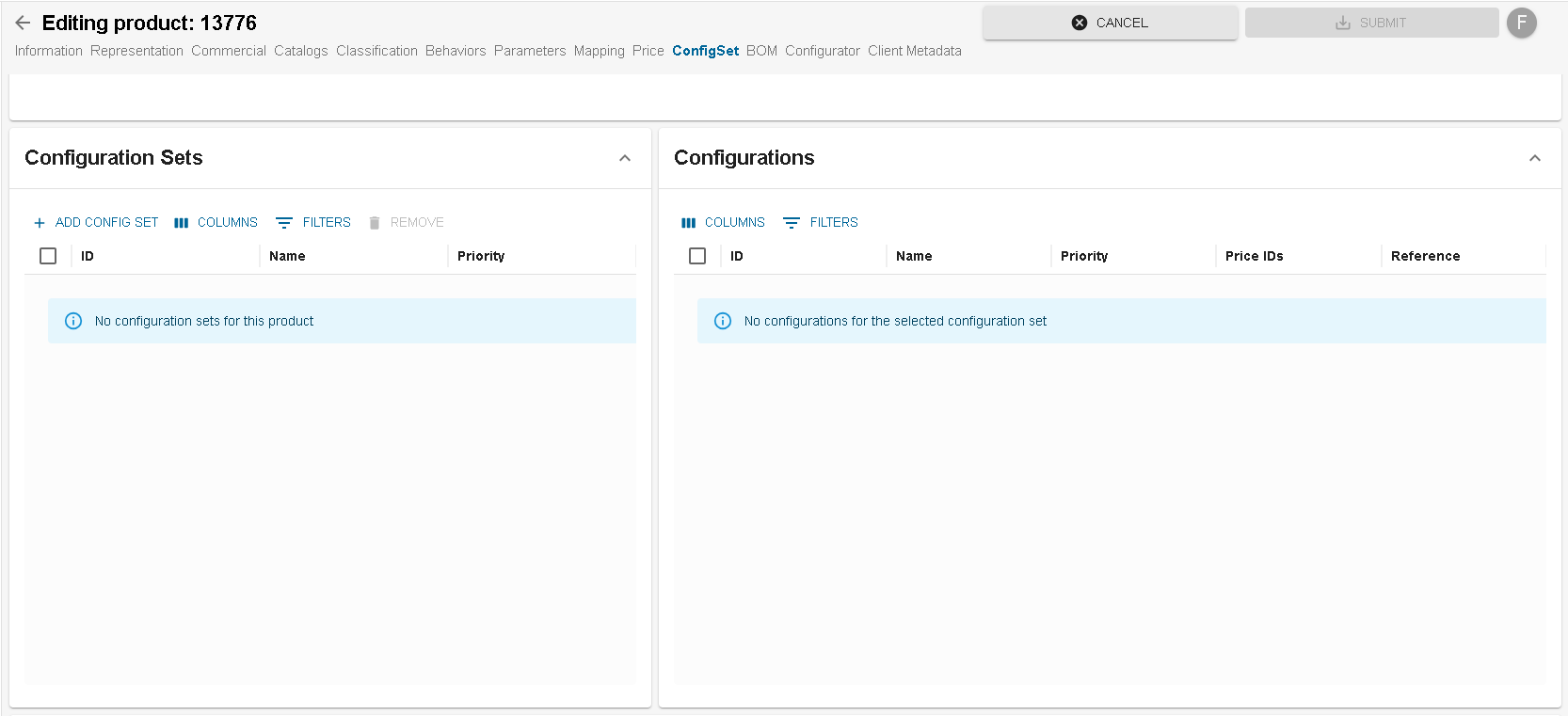
in this part, we can associate configurations from configuration set to a product. First, you need to have some configuration set created in your legal entity (cf doc here)
To add a configuration set to your product, find the configuration set by clicking on "add config set".
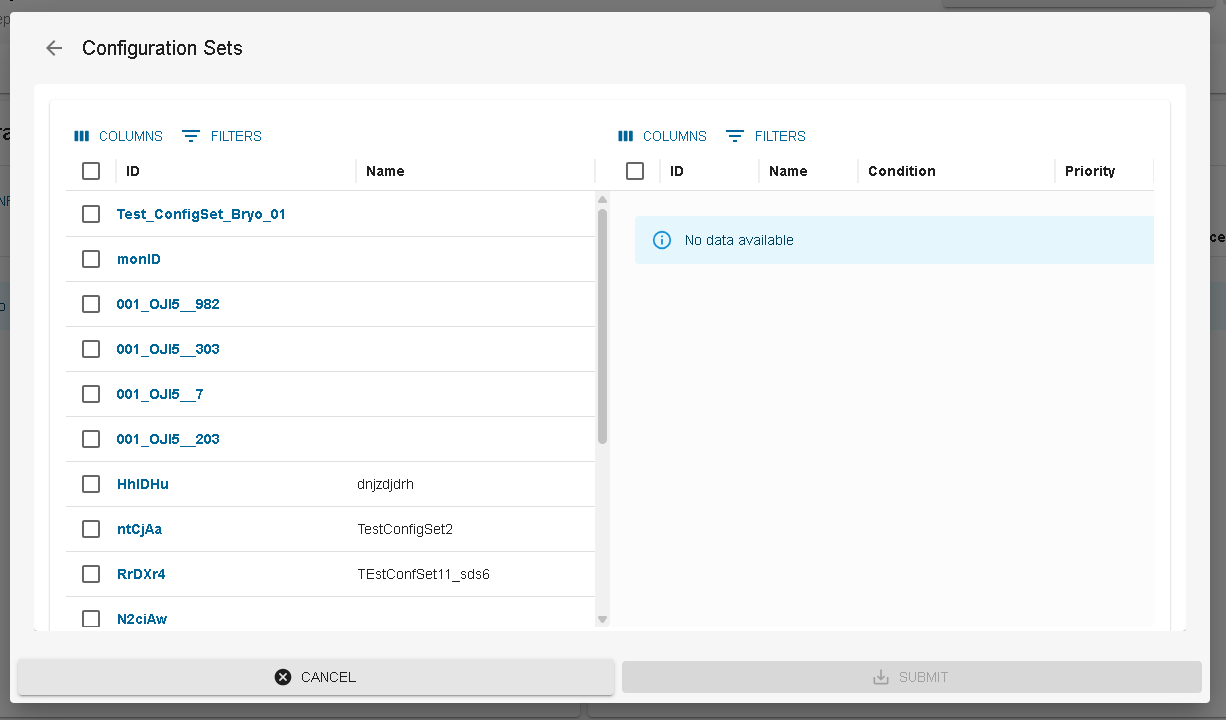
then select the configuration set:
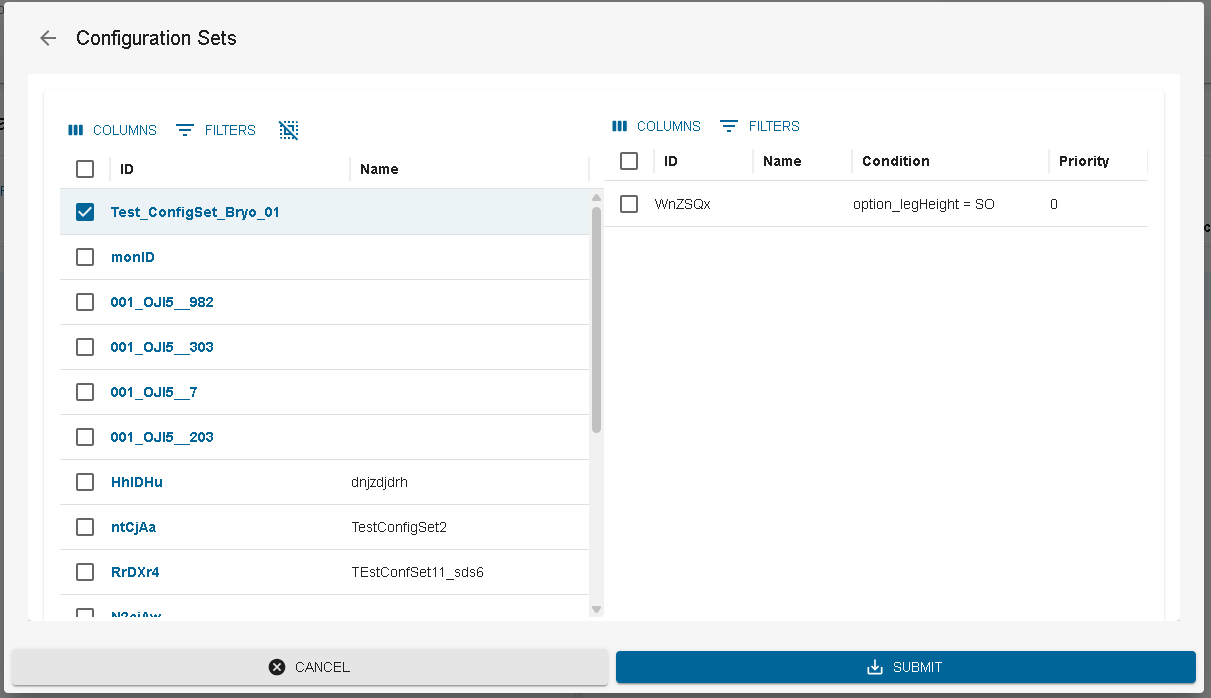
And click on submit.
Then on the product, when you click on the config set, you will see the configurations and you will be able to put the price ids and/or reference that the configuration should override.
1 price id can only be link to 1 configuration. And only price ids within current product are allowed, so first, create your prices under the price panel and give them some ids.
BOM
The bom section let the user fill data that will be only passed in the bom of the application. For now 2 fields are recognized: Code and Code manufacturer. (Used in retail operation)
External Configurator
In this panel, we allow the product to be configurate within an external application from the one it is shown. For that, you should have first create the corresponding configurator (here) and then you find the one that suits your scenario.
Configuration Data is a string that will be passed to the external configurator at launched.
Client MetaData
This field is a free json which should only follow the following restriction:
- Keys are strings limited to 128 characters and can contain only 'A-Za-z0-9_.-'
- All values are strings limited to 256 characters or an array of string limited to 30 keys and each value is limited to 256 characters
- A maximum of 30 keys is allowed.
Kitchen application && Retail Operation
If you are using the kitchen application with SMO, some fields used in SMO can be provided through the client metadata:
"clientMetadata": {
"EAN": "3170720610982",
"catalogName": "Catalogue",
"itemType": "Eléments Cuisine",
"productType": "A",
"manufacturerCode": "Manufacturer_code_01",
"installationDuration" : "1.5",
"unitCostPrice": "89.50",
"productIsStored": "false",
"packedWeight": "5.25",
"packedVolume": "0.025",
"packageCount": "1",
"fixedPackage": "false",
"volumicMass": "640.00",
"deaCode": "06017010240",
"deaOrganization": "ECOMAISON",
"deaUnitCount": "1",
"deaUnitSalesPrice": "0.83",
"deaIsAFixAmount": "false",
"deeeUnitSalesPrice": "0.55",
"dynamicPricing" : "0" or "1"
}
EAN: Used to specify the product's EAN code.
catalogName: Allows you to specify the Retail Operations catalogue in which the imported products will be created. This information is currently stored in freetags.
itemType: Allows you to specify the product class (kitchen item, for example): this data is currently stored in freetags.
productType: Product type:
-
A: Purchased (default value)
-
F: Manufactured
-
P: Service
manufacturerCode: Product manufacturer code (production reference).
unitCostPrice: Product purchase price expressed in the catalogue currency.
productIsStored: Indicates whether this product is managed in stock: Boolean value (false by default).
packedWeight: Weight of the item: expressed in kg: decimal value
packedVolume: Volume of the item's packaging: expressed in m3: decimal value
packageCount: Number of packages for this item: integer value
fixedPackage: Number of packages, fixed or not: Boolean value (false by default)
volumicMass: Density of the product's materials. Can be used to calculate the weight of a shelf unit, for example. Decimal value expressed in kg/m3
deaCode: Product eco-furniture code.This code is made up of 11 characters.
For items such as worktops, where the weight range is unknown, the code will be written as ‘0602001XXX0’. In this
context, depending on the volume of the worktop and the density, we will determine the weight of the worktop to find the
correct weight range.
deaUnitCount: Number of units for calculating the DEA. The vast majority of ecotaxes are calculated by the unit, but some are managed by the kg or tonne. This is a decimal value.
deaUnitSalesPrice: The value excluding VAT is expressed in the currency of the catalogue.
deaIsAFixAmount: This indicates that the dea is applied on a fixed basis. In other words, the number of products ( product quantity) is not taken into account when calculating the total amount of eco-taxes. For example, when you want the quantity to represent the length, you only apply it once (on the board). Boolean value (false by default).
deeeUnitSalesPrice: unit value of the WEEE eco-tax, excluding VAT.
dynamicPricing : to activate repricing of a product with a customer external system: "0" for false and "1" for true (Retail Ops will call the external system to get an updated price for this product)
deaOrganization: DEA Management organization. Retail Ops recognizes 4 organizations:
-
ECOMAISON (default value),
-
VALDELIA:
-
VALOBAT (only DEA Valobat)
-
VALOBAT_PMCB (only PMCB Valobat)
Scroll shortcuts
On the edit page, scroll shortcuts are available to go quickly where you need to go on the product edit page at a specific place.
Clicking on a scroll shortcuts adds an anchor inside the url https://staging-3dcloud.enterprise.by.me/alpha/edit/product/14130?LEID=1#information . Sharing the url with an anchor will allow to reopen the product edit page and scroll automatically to the anchor.